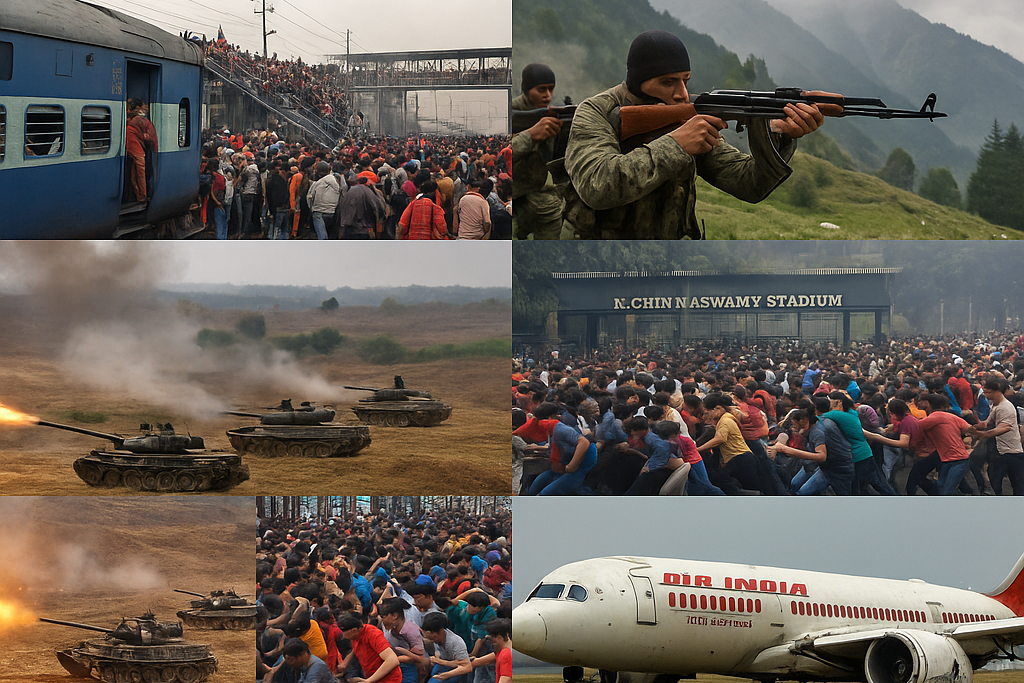
2025:The Curse Going on
January 2025 Events
Los Angeles Wildfires (Early January)
Massive wildfires ravaged California in Jan 2025, killing 24 individuals and destroying over 13,000 structures. The event displaced tens of thousands and revealed the inadequacy of urban-wildland interface fire mitigation strategies.
Insight: Increasingly frequent wildfires highlight the failure of fire-adaptive infrastructure in climate-stressed regions.
UK Winter Floods (January)
The United Kingdom experienced record rainfall and flash floods across England, Scotland, and Wales. Severe disruptions in transportation, agriculture, and public utilities prompted emergency declarations.
Significance: Climate adaptation infrastructure in developed countries is proving insufficient under evolving precipitation extremes.
Tirupati Temple Stampede (January 8)
At the same time, crowd mismanagement during a religious event at Tirumala Temple led to the deaths of six devotees.
Structural bottlenecks and inadequate emergency exits were implicated.
Reflection: Points to an urgent need for scalable crowd control technologies at religious sites.
Kumbh Mela Stampede (January 29)
Later that month, a mass-casualty event at the Kumbh Mela in Prayagraj occurred when panic during a procession led to a deadly crush, with 15–30 deaths reported.
This pointed Fingers in UP Government and Management of Mahakumbh
Lesson: Highlights the need for predictive crowd modeling and pre-event risk mitigation planning.
February 2025 Events
Nepal Earthquake (February 28)
A 6.1-magnitude earthquake caused widespread structural damage in Nepal’s central and western regions. Thousands were injured and displaced.
Analysis: Continues to expose the seismic vulnerability of Himalayan urban centers and the need for enforced building codes.
Delhi Railway Station Crush (February 15)
Overcrowding during a holiday travel surge led to 18 fatalities at New Delhi Railway Station. The incident has prompted renewed scrutiny on urban transit design.
Concern: Urban migration and transport congestion are converging to produce new categories of public hazard.
Knife Attack in Mulhouse, France (February 22)
An isolated stabbing incident in a local marketplace left one dead and seven injured. Authorities suspect ideological extremism, though investigations remain ongoing.
Theme: Illustrates the persistence of low-tech urban terrorism and its societal impact.
March 2025 Events
Cyclones Jude & Honde (March)
Severe tropical cyclones battered Madagascar and Mozambique, displacing thousands and overwhelming emergency response frameworks.
Conclusion: African island and coastal states are emerging as epicenters of climate-driven displacement.
Myanmar Earthquake (March 28)
A catastrophic 7.7–7.9 magnitude quake devastated central Myanmar, killing over 5,300 individuals. Infrastructure collapse and delayed rescue exacerbated the toll.
Critical Point: Reveals state-level gaps in seismic preparedness in politically fragile nations.
April 2025 Events
Pahalgam Terror Attack, India (April 22)
Five militants launched an attack on tourists in Jammu & Kashmir, killing 26 civilians, including pilgrims and international visitors. India’s military response—Operation Sindoor—targeted insurgent sites across the Line of Control.
Implication: Reinforces the enduring volatility of the Kashmir conflict and the regional security implications.
Fireworks Explosion in Gujarat (April 1)
An industrial explosion in Bharuch District caused 21 deaths due to the illegal storage of aluminum powder in a residential zone.
Observation: Highlights the catastrophic potential of informal industry operating outside regulatory oversight.
May 2025 Events
Indo-Pakistani Military Escalation (Early–Mid May)

Following the Pahalgam attack, hostilities escalated sharply between India and Pakistan. Artillery exchanges, drone strikes, and airspace violations culminated in a brief but intense conflict, resulting in dozens of casualties before international actors brokered a ceasefire.
Otherwise it could led to the World War 3.
Strategic Outlook: The event underscores how terrorism can serve as a flashpoint for state-level military escalation in nuclearized regions.
St. Louis Tornado (May 16)
A powerful EF-3 tornado struck residential areas in Missouri, causing widespread property loss and several casualties.
Insight: Reflects the increasing unpredictability of mid-latitude weather systems in the context of global warming.
June 2025 Events
RCB Victory Parade Stampede (June 4)
A celebratory procession following Royal Challengers Bangalore’s first IPL title turned tragic as 200,000 attendees overwhelmed security protocols near Chinnaswamy Stadium. Eleven people died and more than 50 were injured.
Takeaway: Even planned urban events require contingency modeling for scale, mobility, and emergency response.
Air India Boeing 787 Crash (June 12)
One of the deadliest aviation disasters in Indian history occurred when a Boeing 787 crashed near Ahmedabad, killing over 240 passengers. The incident has sparked investigations into fleet maintenance and pilot fatigue.
Broader Implication: Aviation safety is becoming increasingly compromised amid global logistical pressures and aging fleets.
London Vehicle Ramming (June 14)
Two separate vehicle-ramming attacks in Tower Hamlets injured numerous civilians. While investigations are ongoing, authorities suspect ideological motivations.
Trend: Urban Europe remains vulnerable to decentralized acts of vehicular terrorism.
Bridge Collapse in Maharashtra (June 15)
A bridge on a key tourist route collapsed during peak hours, killing two and injuring 32 others. Initial reports suggest structural fatigue and lack of pre-monsoon inspection.
Conclusion: India’s aging public infrastructure poses mounting risks under climate-stressed conditions.
Social Panic and Misinformation — Viral Prophecy (Ongoing in 2025)
An obscure prophecy from manga artist Ryo Tatsuki, predicting a global disaster on July 5, went viral in early 2025. Despite lacking empirical validity, the forecast triggered widespread fear and a measurable decline in Japanese tourism.
Interpretation: Digital misinformation can produce real-world economic and psychological externalities, especially under conditions of global precarity.
Mid-Year Summary: Crisis Metrics
| Sector | Representative Incidents | Estimated Casualties |
|---|---|---|
| Terrorism & Urban Violence | Pahalgam, France, London | 30+ deaths, 40+ injured |
| Environmental Disasters | Earthquakes, cyclones, wildfires | 6,000+ deaths |
| Crowd-Related Disasters | Kumbh, Tirupati, RCB, Delhi | 60+ deaths |
| Aviation Disasters | Air India, Brazil, Nigeria | 250+ deaths |
| Military Conflicts | Indo-Pakistan, Ukraine, Gaza | Dozens and rising |
Final Reflections
The trajectory of 2025 so far has illuminated systemic weaknesses across national boundaries and institutional domains.
These crises are not isolated anomalies; rather, they reflect compounding vulnerabilities shaped by climate change, geopolitical friction, and information chaos. If this year is to serve any constructive function, it must catalyze a fundamental rethinking of global governance, disaster resilience, and collective security.
#SystemicRisk #ClimateCrisis #RCBStampede #PahalgamAttack #GlobalStability #2025Disasters